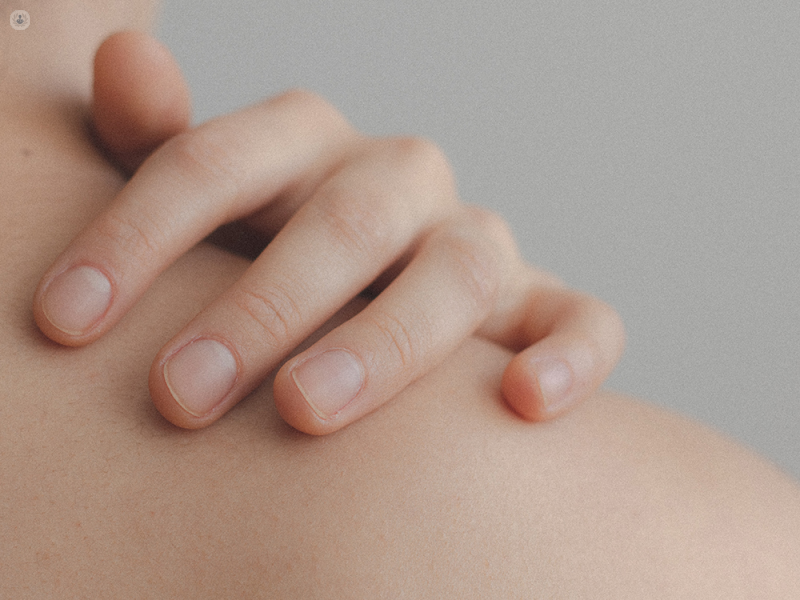What are lipomas and how can they be removed?
Written by:While a lipoma is usually harmless, many people regard them as unsightly and wish to have them removed before they get any bigger. So how can a lipoma be removed? Is surgery necessary and what is the recovery time?
In this article, Miss Sujatha Tadiparthi, a leading plastic surgeon based in Surrey, Kent and London, explains what lipomas are, what to expect when you have one removed and the likely cost of lipoma removal surgery.

What is a lipoma?
Lipomas are soft, painless lumps that grow slowly under the skin over several years. They are non-cancerous, overgrowths of benign fat cells. They can occur anywhere in the body between your skin and the underlying muscle layer where there are fat cells.
What problems can lipomas cause?
Lipomas do not usually cause any symptoms. However, over the years, as they enlarge, you may feel self-conscious of the unsightly swelling, especially if it is in a visible area. In areas that are not so exposed, as the lipoma gets larger, the swelling may start to show through your clothes.
What is the difference between a lipoma and a skin cyst?
It is possible to distinguish between a lipoma and a skin cyst by examining them. A lipoma is softer to the touch, lies deeper in the tissues and is never attached to the overlying skin. A skin cyst, however, tends to be firmer, it is attached to the overlying skin and may have a ‘punctum’ (a small 1mm opening in the skin which is the origin of the cyst).

Do lipomas need to be scanned before removal?
The majority of lipomas grow slowly over a number of years. They can be diagnosed by examination in clinic and do not require any scans.
Any lipoma that is painful, or has grown quickly, or greater than 5 cm in size, require assessment with an ultrasound to exclude any cancerous change prior to removal. This is to exclude a sarcoma or other cancerous growths which often grow quickly within a short period.
Very large lipomas, greater than 10cm, for example, may require an MRI scan to determine the nature of the swelling and its anatomical location.
Are lipomas removed on the NHS?
Lipomas are not routinely removed on the NHS. You may be able to get your lipoma scanned through your GP on the NHS to determine its nature but the majority of lipomas are removed in the private sector as they are harmless and do not cause any problemss.
How are lipomas removed?
Lipomas under 10cms in size can usually be removed under local anaesthetic and you should be able to go home straight after the procedure. Although there may be a small dressing following your minor surgery, you should be able to go home soon after the procedure and return to work the next day.
First, the outline of the swelling is marked on the skin and the skin incision is marked and orientated to lie in the natural skin lines so that the resulting scar is less noticeable. A local anaesthetic is then injected to numb the area and the overlying skin is cleaned with an antiseptic solution. An incision is then made in the overlying skin and the tissues are dissected down until the lipoma is identified. The lipoma is separated from the surrounding normal fatty tissues and removed. The wound is then cauterised to stop any bleeding and closed usually with absorbable sutures and a dressing applied.
The removed lipoma does not routinely need to be sent for analysis but it can be if you prefer for your peace of mind.
Can liposuction remove a lipoma?
Liposuction is not a standard treatment for lipoma removal. Although liposuction leads to minimal scarring, the lipoma would not be completely removed and there is a significantly higher risk of recurrence of the lipoma.
What are the risks of lipoma removal?
There will be a permanent scar after the removal of your lipoma and this is unavoidable. Other risks include, wound infection, poor scarring (with lumpy or stretched scarring) and recurrence of the lipoma.
What is the recovery after lipoma removal?
Although there may be a small dressing following your minor surgery, you should be able to go home soon after the procedure and return to work the next day.
Wherever possible, absorbable stitches that do not require removal are used. However, skin stitches may be required after a small lipoma removal which are removed at seven days on the face and 10 to 14 days on other areas of the body. After two weeks, the wound should be healed and the scar should be massaged daily with a moisturiser.
Although gentle exercise such as walking is fine straight after surgery, more rigorous exercise such as swimming and gym classes should be avoided for three to four weeks after surgery to avoid wound infection and wound separation. Make-up should not be applied to the wound on the face for approximately three weeks or until the wound has fully healed to avoid wound infection.
Can lipomas come back after removal?
If a lipoma has been removed well, the risk of recurrence should be small. The vast majority of lipomas do not return or even if they do recur, do so after many years.
What is the cost of lipoma removal?
Total package cost of lipoma removal (with consultation, surgery and follow) starts from £800 but varies depending on the size, location and whether it is a recurrence.
If you have a lipoma and are interested in having it removed, head to Miss Sujatha Tadiparthi's Top Doctors profile and book a consultation with her.


